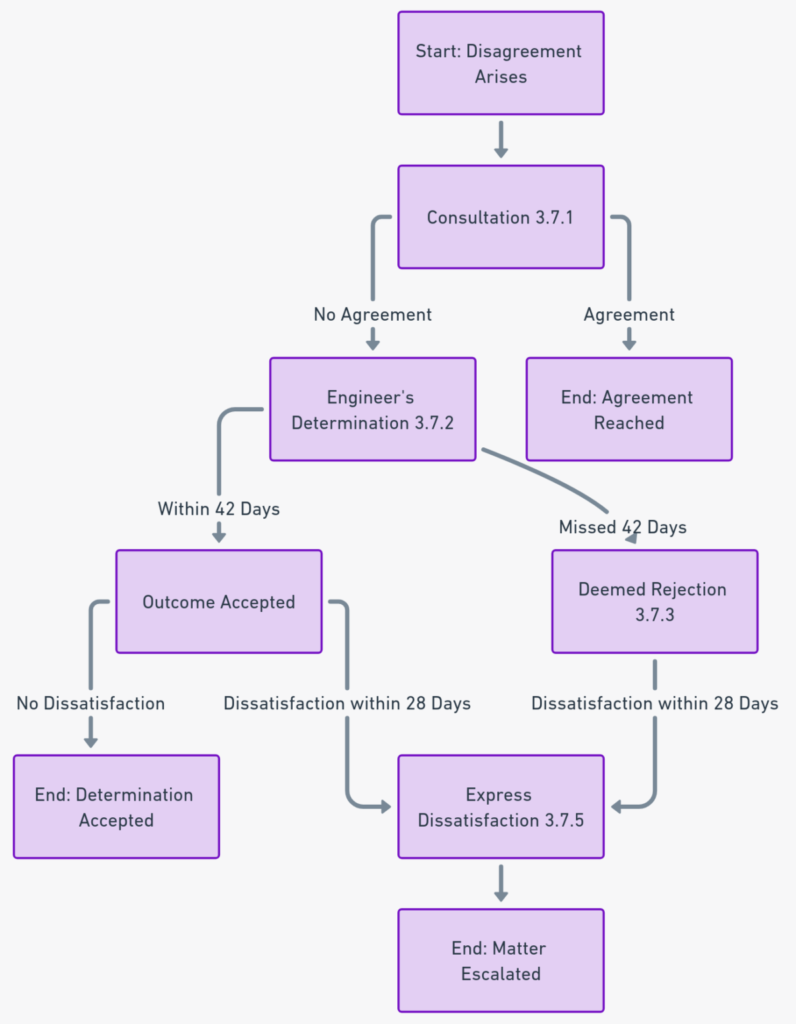Diverse Interpretations of Clause 20.2.4:
- Purpose: The clause serves as a procedural safeguard, ensuring that all claims are substantiated with adequate information and documentation. This is crucial for transparency and fairness in contractual relationships.
- Implications:
- Legal Consequences: Failure to comply with this clause can have severe legal repercussions. For instance, in the U.S., non-compliance could be grounds for dismissal in a court of law.
- Financial Impact: An incomplete or late claim could lead to financial losses, especially if it involves substantial contract variations or extensions.
- Primary Aspects:
- Detailed Description: This is not just a cursory overview but should include specifics like dates, involved parties, and the exact nature of the event.
- Legal Basis: This could be a specific clause in the contract or a relevant law. In the U.S., this might also involve federal or state-specific building codes or environmental regulations.
- Contemporary Records: These are real-time records that serve as evidence. They could be in the form of logs, emails, or even photographs.
- Supporting Particulars: This involves a detailed breakdown of costs or time extensions, often requiring expert estimations or calculations.
- Expert Opinion:
- Timeliness: Legal experts often emphasize the critical nature of the 84-day timeline.
- Documentation: Experts also stress the importance of meticulous record-keeping, aligning with U.S. standards like the American Society of Civil Engineers (ASCE) guidelines for construction documentation.
Interaction with Other Clauses:
- Clause 20.2.3 Contemporary Records: The records kept under this clause serve as foundational evidence for a fully detailed claim. They must be accurate and timely to be considered valid.
- Clause 20.2.5 Agreement or Determination of the Claim: This is the subsequent step where the Engineer reviews the claim and any disagreements. It’s crucial to note that the Engineer’s review will also consider the completeness and timeliness of the fully detailed claim.
Main Points to Keep in Mind:
- Timely Submission: The 84-day period is not just a guideline but a strict requirement. Missing this deadline could invalidate the claim.
- Comprehensive Documentation: Every element required by Clause 20.2.4 must be included. Incomplete claims are often deemed invalid, leading to financial and legal repercussions.
- Engineer’s Role: The Engineer has a dual role—both as a reviewer and as a notifier. They have 14 days to notify the claiming party of the claim’s status, making their timely response crucial as well.
Flowchart and Sequence Diagram

- Event Giving Rise to Claim: This is the starting point where an event or circumstance occurs that leads to a claim. It could be a delay, additional work, or any other event that affects the contract.
- Collect Contemporary Records: The claiming party must collect all relevant records that can substantiate the claim. These records are crucial for the validation of the claim later on.
- Draft Detailed Description: A comprehensive description of the event or circumstance must be drafted. This serves as the basis for the claim and should be as detailed as possible.
- Consult Legal Team: Before proceeding further, it’s advisable to consult with legal experts to ensure that the claim has a solid contractual and/or legal basis.
- Calculate Amount/EOT (Extension of Time): The claiming party must calculate the amount of additional payment or extension of time being claimed. This should be supported by the contemporary records and detailed description.
- Submit Fully Detailed Claim: The claim, now fully detailed, is submitted to the Engineer for review. This must be done within a specific time frame, usually 84 days or as agreed upon.
- Engineer’s Response within 14 days: The Engineer has 14 days to respond to the claim. The Engineer’s response will determine the validity of the claim.
- Claim Valid?: This is a decision point. If the Engineer validates the claim, it proceeds to Clause 20.2.5 for further action. If not, the claim is deemed invalid, and the claiming party is notified.
- Proceed to Clause 20.2.5: If the claim is valid, it moves on to the next clause for agreement or determination of the claim.
- Claim Deemed Invalid: If the claim is not validated by the Engineer within the 14-day period, it is considered invalid, and the claiming party is notified accordingly.


- Claiming Party Becomes Aware: The process starts when the claiming party becomes aware of an event or circumstance that gives rise to a claim. This is the triggering event for the entire clause.
- 84-Day Window: The claiming party has 84 days to submit a fully detailed claim to the Engineer. This is a critical time window, and missing it could lead to the claim being deemed invalid.
- Engineer’s 14-Day Response: After receiving the fully detailed claim, the Engineer has 14 days to respond. If the Engineer fails to respond within this period, the claim is deemed to be a valid notice.
- Disagreement from Other Party: If the other party disagrees with the deemed valid notice, they must notify the Engineer detailing their disagreement.
- Engineer Reviews Disagreement: The Engineer then reviews the disagreement as part of the agreement or determination of the claim under Sub-Clause 20.2.5.
- Claiming Party Disagrees with Engineer: If the claiming party disagrees with the Engineer’s notice or believes there are circumstances justifying late submission, they must include these details in their fully detailed claim.
- Continuing Effect: If the event or circumstance has a continuing effect, then Sub-Clause 20.2.6 comes into play, which deals with claims of continuing effect.
Real-World Instances and Case Studies Concerning Clause 20.2.4
Case Study 1: Delay Due to Unforeseen Geological Conditions
- Scenario: A construction company in California was contracted to build a tunnel. During excavation, they encountered unforeseen geological conditions that were not accounted for in the initial geological surveys.
- Application of Clause 20.2.4:
- The contractor submitted a fully detailed claim within the 84-day period, including geological reports, photographs, and expert opinions.
- The claim also cited California’s building codes and environmental laws to substantiate their case.
- Outcome: The Engineer reviewed the claim and granted an Extension of Time (EOT) and additional payment to the contractor for dealing with the unforeseen conditions.
Case Study 2: Change in Environmental Regulations
- Scenario: A Texas-based oil and gas company had to halt operations due to sudden changes in environmental regulations.
- Application of Clause 20.2.4:
- The company submitted a fully detailed claim within 84 days, including legal documents highlighting the change in regulations.
- They also included financial models showing the impact on the project’s budget.
- Outcome: The engineer reviewed the claim and agreed to a reduction in the Contract Price, as the company had to invest in new technologies to comply with the regulations.
Sample Letters Related to Clause 20.2.4
Scenario 1: Submitting a Fully Detailed Claim for Unforeseen Geological Conditions
[Your Company’s Letterhead]
[Date]
[Engineer’s Address]
Subject: Fully Detailed Claim under Clause 20.2.4 for Project [Project Name]
Dear [Engineer’s Name],
We are writing to submit a fully detailed claim in accordance with Clause 20.2.4 of our contract for the [Project Name].
[Include all the required details as per Clause 20.2.4]
We kindly request you to review this claim within the stipulated 14-day period as per the contract.
Sincerely,
[Your Name]
[Your Position]
Scenario 2: Disagreeing with Engineer’s Notice
[Your Company’s Letterhead]
[Date]
[Engineer’s Address]
Subject: Disagreement with Engineer’s Notice Regarding Clause 20.2.4 for Project [Project Name]
Dear [Engineer’s Name],
We have received your notice dated [Date of Engineer’s Notice] concerning our claim under Clause 20.2.4. We disagree with your assessment for the following reasons:
[State your reasons]
We request a thorough review of this disagreement as per Clause 20.2.5.
Sincerely,
[Your Name]
[Your Position]
Structured Checklists for Clause 20.2.4
Checklist 1: Proficient Execution and Deployment of Clause 20.2.4
| Task | Responsible Party | Deadline | Status |
|---|---|---|---|
| Identify the event giving rise to the claim | Contractor/Engineer | Within 7 days of event | Pending/Complete |
| Gather all contemporary records | Contractor/Engineer | Within 14 days of event | Pending/Complete |
| Draft a detailed description of the event | Contractor/Engineer | Within 21 days of event | Pending/Complete |
| Consult legal team for the contractual basis of the claim | Legal Team | Within 28 days of event | Pending/Complete |
| Calculate the amount for additional payment or EOT | Financial Team | Within 35 days of event | Pending/Complete |
| Submit the fully detailed claim | Contractor/Engineer | Within 84 days of event | Pending/Complete |
Checklist 2: Applying and Overseeing Clause 20.2.4
| Task | Checkpoints | Verification Method |
|---|---|---|
| Detailed description of the event | Is the description clear and comprehensive? | Review by Legal Team |
| Contractual basis of the claim | Is the legal basis well-articulated? | Review by Legal Team |
| Contemporary records | Are all necessary records included? | Cross-verification |
| Amount claimed | Is the calculation accurate and justifiable? | Financial audit |
Checklist 3: Monitoring the Execution of Clause 20.2.4
| Monitoring Aspect | Frequency | Responsible Party |
|---|---|---|
| Status of claim preparation | Weekly | Project Manager |
| Legal consultations | As needed | Legal Team |
| Financial calculations | As needed | Financial Team |
| Submission to the Engineer | Once | Contractor/Engineer |
FAQs
Is the 84-day period flexible?
No, the 84-day period is strict unless otherwise agreed upon with the Engineer.
Can the Engineer reject the claim based on incomplete contemporary records?
The Engineer can question the completeness but cannot outright reject the claim based on this alone.
Is the Engineer’s failure to respond within 14 days considered as acceptance of the claim?
Yes, if the Engineer does not respond within 14 days, the claim is deemed valid.



